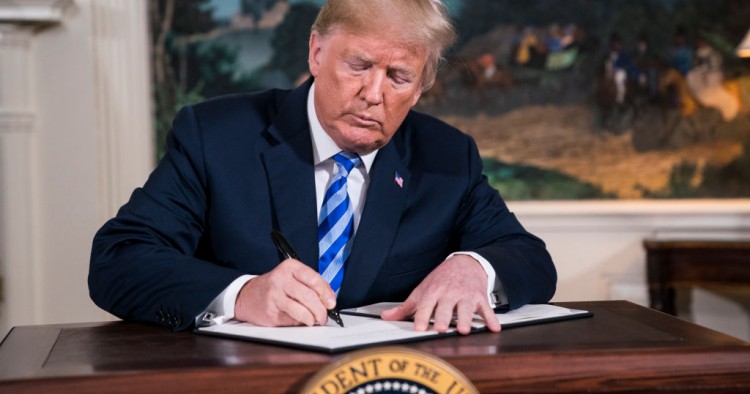Both the U.S. State Department and the American intelligence community have concluded that President Donald Trump’s “maximum pressure” policy toward Iran is not working. Yet, Trump seems determined to carry on. In addition to reimposing sanctions, he has stated that the U.S. presence in Iraq should be used to “watch” Iran. Meanwhile, the recent Warsaw summit could be seen as a prelude to the beginning of the end of Europe’s efforts to salvage the Joint Comprehensive Plan of Action (JCPOA), as the Iran nuclear deal is officially known.
In general, compellence, or a policy designed to bring about a change in another actor’s ongoing behavior, cannot succeed unless there is a sufficient “balance” between the credibility of a state’s commitments to reward “good” behavior and its threats to use force. On this score, “maximum pressure” fails the test; it focuses entirely on negative inducements without providing incentives for Iran to comply with existing agreements, much less move forward with new ones. It demands that Iran alter its behavior across a variety of fronts, from rolling back its forces in Syria to giving up gains made under the JCPOA, to the ill-defined notion of behaving like a “normal” nation. The sheer scope of this agenda makes it difficult to reach any sort of bargain which avoids outright war.
Therefore, the Trump administration would be better advised to reduce the scope of its objectives. To achieve its stated goal of changing Iran’s policies, the U.S. should adopt a more proportional approach that focuses on Tehran’s most threatening actions, such as its ballistic missile tests. Such a strategy should involve a package of negative and positive measures that would make compliance attractive for the Iranian regime, while lowering the reputational costs of negotiating with the Trump administration. To be clear, a prerequisite for any engagement with Iran on non-nuclear issues would be for the U.S. to rejoin the Iran nuclear deal.
One potential first step would be to focus on limiting Iran’s ballistic missile tests. Conventional wisdom suggests that its ballistic missile program is decoupled from its support for regional actors such as Hezbollah, Hamas, and Islamic Jihad. Iran’s missiles appear to be dedicated to deterring attack from unfriendly actors in the region, driven by its experience in the 1980-88 war with Iraq as well as the attrition of its air force under sanctions.
Convincing Iran to give up its ballistic missile tests will, therefore, be difficult, particularly given the aggravated security dilemma in the region. As such, to offer Iran a face-saving way forward, measures that could be placed on the table — in addition to rejoining the JCPOA — should include negative security assurances on the conventional level. Iran should also be allowed to maintain the missile defense systems it has purchased from Russia, in exchange for a commitment not to sell them to third-party countries. Other inducements could include gradually lifting sanctions on its ballistic missile program, while maintaining restrictions to curb Tehran’s human rights abuses at home and alleged support for terrorism abroad. The most prudent approach would be to act through a third party friendly to both Iran and the U.S., such as Algeria or Oman. Moreover, given the mistrust which has been added to the decades-long estrangement between the two countries, agreed steps should be staggered over time.
On the U.S. side, there are of course major impediments to a change in policy. The Trump administration’s foreign policy has to some extent been defined by its tough rhetoric against the Islamic Republic. Indeed, President Trump’s main justification for withdrawing from the JCPOA was that Iran’s regional policies violated the “spirit” of the agreement. As such, abandoning the policy of “maximum pressure” would be a flip-flop on a par with Trump’s diplomacy with North Korean leader Kim Jong-Un. However, unlike most politicians, inconsistency does not seem to bother the U.S. president — which bodes well for the prospective engagement with Iran.
For its part, the Iranian leadership could choose to continue trying to wait out the Trump administration in hopes that a new U.S. president will come to power in 2021 and rejoin the JCPOA. However, if a week is a long time in politics, 22 months is an eternity. This strategy carries major risks for Iran; it is unclear whether the Islamic Republic can afford more economic pressure and domestic turmoil. Moreover, betting on Trump’s defeat in the next presidential elections would be a big gamble.
With these considerations in mind, if President Trump wants to strike a better deal with Iran, he needs to lower the reputational costs for the regime of bargaining with the United States. When great powers try to compel weaker states, the latter have a strong incentive to drive a hard bargain because of the potential reputational damage they may suffer in the future. Trump may be tempted to take a page from his North Korean playbook, but that is unlikely to work with the Iranians; for instance, while flattery from the U.S. president could be useful in Pyongyang, it is a political minefield in Tehran. Rather, the focus must be on action rather than words.
With just under two years left in his first term, President Trump ought to recognize that “maximum pressure” is a failed and failing policy. By restricting its demands and balancing the threat of force with positive inducements, his administration could achieve more and replace a disastrous policy with something more pragmatic.
Dr. Albert B. Wolf is the Dean of the College of International Studies at the American University of Kurdistan. The views expressed in this article are his own.
Jabin Botsford/The Washington Post via Getty Images
The Middle East Institute (MEI) is an independent, non-partisan, non-for-profit, educational organization. It does not engage in advocacy and its scholars’ opinions are their own. MEI welcomes financial donations, but retains sole editorial control over its work and its publications reflect only the authors’ views. For a listing of MEI donors, please click here.













